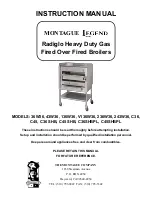
CONTROL METHODS
HeatNet Control V3
Page 24
Heating Control Methods
An overview of the (5) methods for controlling the Torus
Series boiler are presented here. They are outlined in more
detail at the end of this section.
Heating Method 1
The first method is to use the Torus Series boiler in its
stand-alone modulating method. This method uses a PID
algorithm to maintain a setpoint and is enabled using the
HEAT DEMAND input. Closing a relay contact or switch
across the HEAT DEMAND input will cause the Master
boiler to control all member boilers using H-Net.
A member boiler may also be controlled by the HEAT
DEMAND input (LOCAL mode). The member boiler will
then ignore commands from the Master and maintain its
LOCAL SETPOINT at the supply sensor.
Basic Single Boiler
MASTER
System Header Sensor
System Return
Sensor
Lo
ca
l P
u
m
p
System Pump
E
xp
a
n
sio
n
T
an
k
Backflow
Prevention
Pressure
Reducing
Ball Valve
Sy
st
em
P
u
m
p
Su
p
p
ly
H
ea
d
er
Se
n
so
r
HeatNet
Outdoor Air Sensor
MIN 3X PIPE DIAMETERS
MAX 10X PIPE DIAMETERS
BETWEEN CENTERS
WM
Water Meter
System Supply
Sy
st
em
R
e
tu
rn
Se
n
so
r
Note:
The example drawings in this section are simplified.
They are meant to illustrate connections to the HeatNet V3
control. Only major components are illustrated. The system
engineer must ensure additional safeties, piping,
maintenance valves, and components meet code
requirements and safe operation.
Heating Method 2
The second method is to view the Torus Series boiler as two
separate boilers or as a HIGH/LOW boiler using T1 & T2.
Heating Method 3
The third method is to allow a remote 4-20mA or 0-10VDC
signal to control the firing rate (modulation) of the boiler
using the 4-20mA input, along with the 4-20mA REMOTE
ENABLE input.
Heating Method 4
The fourth method turns the boiler ON and OFF @ 100%
modulation using the AA terminal.
Heating Method 5
The fifth method uses an RS485 digital communications
cable with the MODBUS protocol. The boiler is controlled
by writing and reading registers using MODBUS
commands. A bridge module may also be used to convert
BACnet or LonWorks protocols to MODBUS.
Short cycling may occur when a firing rate is
sent to a member boiler that would cause the
supply temperature to raise high enough to
trip the operating limit (low flow rate). After
the supply temperature falls, the boiler would
restart, and the process may continue. A
member boiler would use its supply (outlet)
sensor to protect itself from short cycling by
limiting the firing rate coming from the
Master. This occurs when the member’s
supply temperature increases above the
(OPERATE LIMIT- OPERATE LIMIT
BAND).
Operating Limit
When the Master boiler or an external control input is used
to control a member boiler (i.e., AA, T1-T2, 4-20mA, H-
Net), a software operating limit on the member boiler will
be used to limit the maximum output of the member boiler.
This operating limit can be adjusted in the
SETTINGS:
SETPOINTS: OPERATE LIMIT
.
There is also an associated operating limit band that must be
set in conjunction with the operating limit to help prevent
this LIMIT from being reached. Its purpose is to limit the
output of the boiler as it approaches the operating limit. If
the band is set to 10 degrees, then for every degree that it
approaches the operating limit, the maximum output will be
lessened by 10%. With a band of 20 degrees, for every
degree that it approaches the band, the maximum output will
be lessened by 5%. You can think of this operating limit as
a smart Aquastat which prevents the High Limit from
tripping. This method minimizes boiler short cycling when
using external inputs. The minimum setting is 1 degree and
effectively turns the limit band OFF. The default setting is
20F.
Содержание HEATNET 3.0 Torus Series
Страница 15: ...SETUP OPERATION HeatNet Control V3 Page 15 Mixed Boilers Example Condensing Non Condensing...
Страница 135: ......
















































